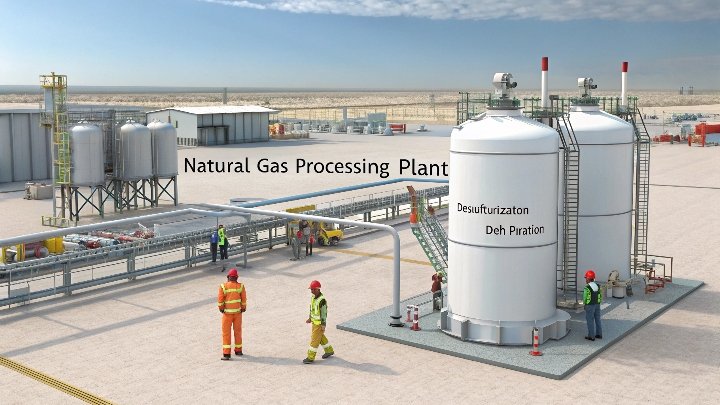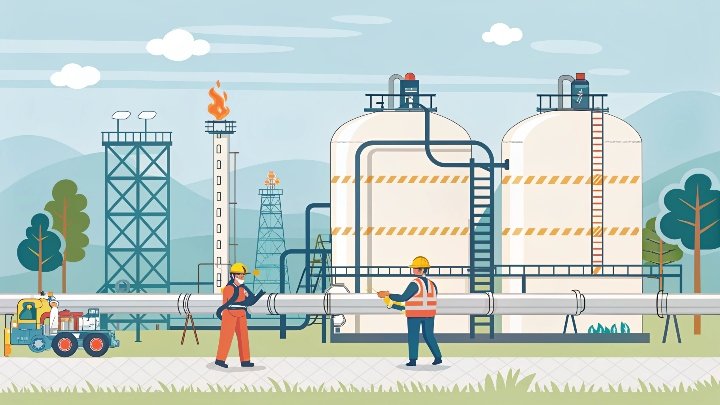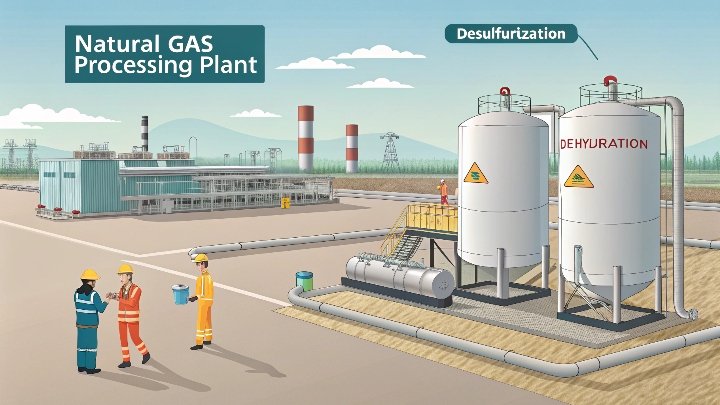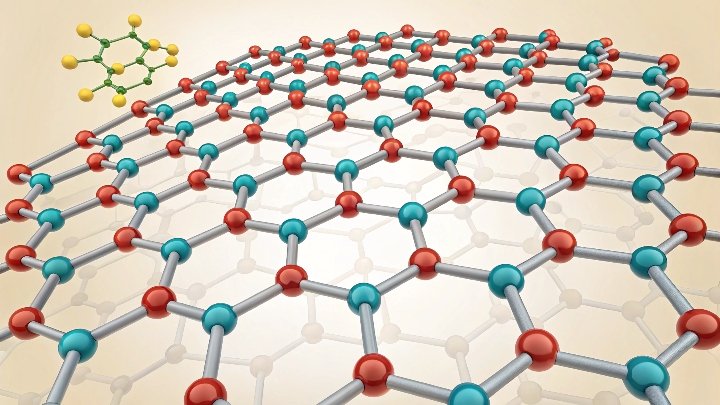Many natural gas processes face moisture and contaminant challenges. That can lead to pipeline corrosion or subpar gas quality. I see how molecular sieves solve these concerns.
Molecular sieves remove water and contaminants from natural gas through selective adsorption. They target molecules by size and polarity, capturing moisture, CO2, H2S, and heavy hydrocarbons. This method helps operators achieve strict pipeline requirements, enhance gas quality, and prevent corrosion or freezing.
I learned early in my career that proper sieve selection is vital. I once managed a facility where we chose 3A molecular sieves to reach a -110°F dew point. This advanced dehydration allowed us to meet strict pipeline standards. Now, I want to explain how these sieves remove contaminants, achieve efficient dehydration, and enable flexible regeneration.
Removing Contaminants: How Molecular Sieves Purify Natural Gas?
Many facilities struggle with contaminants that damage equipment and reduce gas value. This can be costly. I use molecular sieves to trap unwanted components and protect process integrity.
These sieves use tiny pores to capture specific molecules, like CO2 or H2S, while letting methane flow. They work by size exclusion and surface affinity. This filtration extends equipment life, improves product purity, and prevents pipeline corrosion. That is how they tackle contaminants and protect overall gas quality.
To understand how molecular sieves remove contaminants, I look at their structure. They have a crystalline network with uniform pores. This network attracts certain molecules based on size and polarity. In my work with natural gas facilities, I focus on removing H2S, CO2, and heavy hydrocarbons. Each contaminant has its own impact on gas quality.
Contaminant Behavior
H2S is toxic and corrosive. CO2 lowers the heating value. Heavy hydrocarbons can foul downstream equipment. By selecting the right molecular sieve, I can target each contaminant effectively. For instance, I might choose 5A or 13X sieves if the feed gas has a high concentration of heavier components. If I am primarily concerned with acid gases, I might lean towards specialized sorbents optimized for sulfur or CO2 removal.
Adsorption Efficiency Table
| Sieve Type | Target Molecules | Typical Applications |
|---|---|---|
| 3A | H2O | Dehydration |
| 4A | H2O, some CO2 | General Purification |
| 5A | H2O, CO2, H2S | Natural Gas Cleanup |
| 13X | H2O, CO2, H2S | Acid Gas Removal |
This table helps me pick the right sieve for each challenge. I also consider operating conditions, such as temperature and pressure. Sometimes I adjust the cycle time to optimize removal. If contaminants are high, the adsorbent bed may saturate faster, so I use shorter cycles. Conversely, if feed is fairly clean, I can extend the cycle. I must also track pressure drop across the bed, ensuring that the flow remains stable. By managing these details, I get a smoother operation and a cleaner final product.
Molecular Sieves: The Key to Efficient Natural Gas Dehydration
Moisture in natural gas can form hydrates and cause freezing in pipelines. This is a serious issue. I choose molecular sieves to remove water and improve operational stability.
By adsorbing water, molecular sieves lower dew points to extreme levels, such as -110°F. This prevents ice formation, lowers corrosion risk, and allows compliance with pipeline specifications. That is why they are the primary choice for efficient dehydration. They offer reliable, consistent performance in many natural gas facilities.
I find dehydration to be one of the most crucial steps in gas processing. Water can create hydrates, which obstruct pipelines and damage downstream equipment. Molecular sieves address this by selectively adsorbing water molecules from the gas stream, resulting in a very low dew point. I have overseen projects where we aimed for a dew point as low as -110°F, which requires a specialized approach. We choose 3A molecular sieves because their pore size suits water removal and excludes larger hydrocarbons. This protects the sieve from becoming saturated with heavier components.
Key Factors
I must consider inlet conditions, like gas temperature and flow rate. If the gas is too warm, the water loading might be higher, so I might need more adsorbent or a cooler feed. Another factor is cycle time. During adsorption, the sieve bed collects water until it reaches capacity. After that, the bed needs regeneration. If I do not regenerate properly, water remains on the sieve, lowering its efficiency.
Regeneration Approach
In one facility, I used waste heat from a gas turbine to regenerate the sieve bed. That saved energy and reduced emissions. The regeneration temperature can reach 400–600°F, which drives off water. The challenge is balancing the regeneration time so we do not overheat the sieve or shorten its lifespan. I also implement a cooldown phase before switching the bed back online, preventing thermal shock. By fine-tuning these parameters, I achieve consistent dehydration results, improve pipeline safety, and maintain efficient operations. Over the years, I have seen that proper system design, including bed sizing, regeneration scheduling, and temperature management, is critical for stable, long-term dehydration performance.
Optimizing Natural Gas Processing: The Role of Molecular Sieve Selection and Regeneration.
Many plants face downtime and cost overruns when sieves are not chosen or maintained well. I optimize my systems by selecting the right adsorbent and perfecting the regeneration cycle.
Molecular sieve optimization involves matching pore size with target contaminants, managing adsorption cycles, and ensuring robust regeneration. If I choose the wrong sieve or skip thorough regeneration, I risk pressure drop and poor gas quality. That is why careful selection and proper regeneration create a stable, cost-effective operation.
I see selection and regeneration as connected steps that influence each other. I start by analyzing the feed gas composition, as well as the presence of any contaminants like sulfur or heavy hydrocarbons. I also check the operating temperature and pressure. That data helps me decide which sieve grade, such as 3A, 4A, 5A, or 13X, fits best. If I need deeper dehydration, I might prefer 3A. If I want to remove heavier molecules, I might pick 5A or 13X. It is not just about picking any sieve; it is about matching it with the actual gas composition.
Cycle Design
Once I choose the sieve, I design the adsorption and regeneration cycle. Each cycle has an adsorption phase, where the gas flows through the bed, and a regeneration phase, where a hot purge gas removes the adsorbed components. The time for each phase depends on the system’s throughput, contamination level, and the total adsorbent volume. If I shorten the adsorption phase, the bed might not get fully loaded, leading to inefficiencies. If I extend it too long, there is a risk of breakthrough. During regeneration, I use either external heaters or residual process heat to bring the sieve to the right temperature.
Monitoring and Maintenance
I check bed temperatures and pressure drops to confirm that the sieve is working properly. If I see a high differential pressure, it might mean the bed is fouled. Routine analyses of gas composition confirm that the sieve is still performing. If performance drops, I may switch out the sieve or tweak regeneration parameters. Through this method, I maximize the lifespan of the adsorbent and keep gas quality at the required standards.
Conclusion
Molecular sieves are essential for contaminant removal and dehydration. By selecting the right adsorbent, fine-tuning cycles, and ensuring good regeneration, I consistently meet demanding natural gas specifications.






